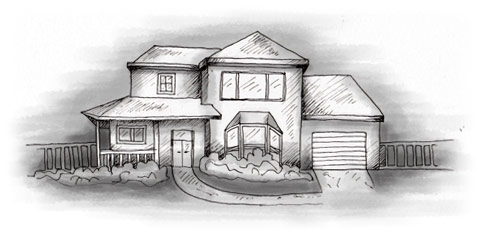The purchase and restoration of these typical country homes is becoming increasingly popular among foreigners, especially those keen to establish small hotels or bed and breakfast businesses. However, the vast majority of foreigners purchase on the costas or islands where most property generally consists of apartments, townhouses or villas, most of which are purpose-built for the holiday-home market.
Below is a brief guide to the types of property available, including country properties.
Apartments
Apartments and flats ( apartamento or piso) abound in Spain and the vast majority of Spaniards live in apartment blocks, particularly in large towns and cities. Resorts such as Benidorm, Lloret del Mar, Magaluf and Torremolinos are smothered to the point of saturation with apartment blocks purpose-built for the holiday market, although it’s now difficult to find any stretch of popular coastline without a sky-line of apartment blocks (and high-rise hotels). Construction of apartment blocks have continued unabated throughout Spain (as the numerous cranes dotting the horizon testify) since the late ’60s, and there’s still a good market for both buyers and sellers.
The quality and size varies enormously, from tiny studio apartments crammed into multi-storey blocks with ’70s-style bathroom fittings to spacious marble-floored apartments complete with all mod-cons. They may be situated in small side streets and be dark and cramped, while others are spacious front-line beach or golf developments with views stretching as far as the eye can see. Prices range from €80,000 for a small one-bedroom apartment in a less popular resort (e.g. on the Costa Cálida) to well over €1m on Marbella’s golden mile with just about everything in between. Bargain apartments are few and far between in popular areas and lower-priced properties usually require extensive modernisation and refurbishment.
Under Spanish law, all owners of apartments (irrespective of their number or size) are members of the community of owners ( comunidad de propietarios) and as such must abide by the community’s rules and regulations and pay community fees.
Advantages of apartments include low maintenance (once you’ve carried out any necessary work), security – especially if the block has 24-hour security or a concierge ( portero) – and the use of communal gardens and pool (and possibly other facilities such as tennis courts). Apartments situated in towns also have the added advantage of local facilities and amenities within walking distance. Disadvantages are noisy neighbours, poorly-maintained communities and crowded complexes during holidays.
Townhouses
Townhouses ( casa adosada) are generally rows of terraced houses, often in typical regional style set around communal gardens with a pool. Townhouse complexes are increasingly popular around large towns and cities, particularly Madrid, where there are vast suburbs lined with row upon row of townhouses. In coastal resorts townhouses are often built in a style known as the ‘Mediterranean village’ ( pueblo Mediterráneo) and houses may be white-washed or, as is increasingly popular nowadays, painted in shades of blue and yellow.
Townhouses are usually spacious and often have three or four floors, including a basement for a garage and storage, and a roof area with a roof terrace known as a solarium. Townhouses generally have little outside space or garden except for a small patch at the front and back, often paved as a patio. Construction tends to be recent and is generally of reasonable to good quality.
Townhouses usually form part of a community property and owners must abide by the community’s rules and regulations and pay community fees.
Townhouses are generally located on the outskirts of resorts and towns or within urbanisations (see below), with prices ranging from e100,000 for a one-bedroom townhouse in a less popular area, e.g. Costa de la Luz, to over e750,000 for three bedrooms in a top quality resort. Advantages include low maintenance, plenty of living and storage space, use of communal gardens and pool without the upkeep, and community living with fewer neighbours than in an apartment. On the other hand, you may suffer from noisy neighbours, poorly-maintained communities, crowded complexes during holidays and exhaustion from climbing the endless flights of stairs!
Villas
In general, the Spanish don’t live in detached houses ( casa, chalet or villa) and in many large towns and cities it’s difficult to find a large house unless it’s a mansion or palace belonging to the local aristocracy. On the coast, however, detached houses abound and are generally owned by foreigners or wealthy Spaniards who use them as second homes. Some villas form part of a complex and may share communal gardens and a pool, and are situated on small individual plots, while others are set in huge grounds.
Villas built in the ’60s and ’70s tend to be single-storey and often need extensive renovation work, particularly if they’ve only been used as holiday homes and not properly maintained. Construction quality may be poor in older properties, although the quality is usually excellent in newer properties, which tend to be at least two storeys and more spacious than older villas. Prices start at €200,000 for a small two-bedroom villa with a communal pool in a less popular area, although villas in many parts of the Costa del Sol, the northern part of the Costa Blanca, and Ibiza and Majorca cost over €1m.
If a villa forms part of a community property, owners must abide by the community’s rules and regulations, and pay community fees.
Urbanisations
Urbanisations ( urbanizaciones) are purpose-built estates or developments which may include apartments, townhouses and villas. They form an essential part of Spanish resort landscapes and cities and most popular areas are packed with them. Some have been part of the holiday home market since the first sun-worshippers arrived in Spain in the ’60s, although most are more recent.
Some are small with a limited number of properties, while others are huge complexes, almost towns in their own right, such as Sitio de Calahonda on the Costa del Sol or La Marina in the southern Costa Blanca. Property available on urbanisations is varied and caters for different needs and price ranges, and many urbanisations contain a mixture of apartment blocks and individual villas.
Facilities and amenities vary greatly from extensive shopping facilities, transport systems and sports complexes to little more than a local bar (which may only be open in summer). Some urbanisations have permanent resident populations while others turn into ghost towns outside the high season. Many urbanisations are populated mainly by foreigners and some tend to cater for one nationality only, e.g. British or German, particularly on the Costa del Sol, Costa Blanca and the islands.
Advantages include general tranquillity, pleasant surroundings, good security (if the urbanisation has private security) and a ready-made foreign community often with a good social scene. Disadvantages are few amenities and facilities, limited public spending (local councils collect rates and local taxes enthusiastically, but invest as little as possible in urbanisations) and a possibly claustrophobic expatriate atmosphere.
Most urbanisations are community properties, and owners, who automatically form a community of owners, must abide by the community’s rules and regulations and pay community fees. In some cases, the property may belong to a sub-community within the larger community of the urbanisation.
Country Properties
As property prices have risen on the coast and resort areas have become more crowded, foreigners are increasingly looking further inland to the Spanish countryside in their search for property. Property here, known as fincas – a term loosely used to describe just about anything from a hut to a well-preserved farmhouse – is generally cheaper than resort property and widely available except in areas in the immediate vicinity of coastal resorts. Fincas range from a ruin set in a large area of land to cottages or large country homes, sometimes together with working farmland.
Almost all fincas come with large plots of land and may include fruit trees, olive groves or meadows. Renovation is almost always necessary unless you pay a premium and buy a property that’s already been modernised.
Advantages of country properties include cheaper prices, peace and quiet, low local taxes and the opportunity to live in the ‘real’ Spain. On the other hand, rural properties usually involve extensive maintenance as well as restoration work, utilities may be poor or non-existent, amenities and facilities are often some distance away and you don’t have the advantage of a ready-made community. The good news is that Spanish village communities are generally among the friendliest and most welcoming in the world!
This article is an extract from Buying a home in Spain. Click here to get a copy now.


